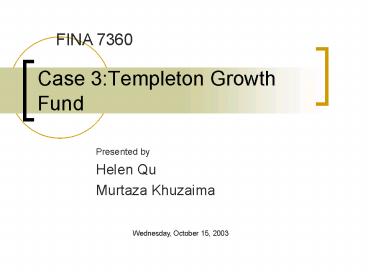Case 3:Templeton Growth Fund - PowerPoint PPT Presentation
1 / 15
Title:
Case 3:Templeton Growth Fund
Description:
Deriving the weights of the Constrained Optimal Portfolio. Countries with weights above the cap are reduced to the cap limit of 6.5 ... – PowerPoint PPT presentation
Number of Views:27
Avg rating:3.0/5.0
Title: Case 3:Templeton Growth Fund
1
Case 3Templeton Growth Fund
FINA 7360
- Presented by
- Helen Qu
- Murtaza Khuzaima
Wednesday, October 15, 2003
2
Assignment
- Analyze Templeton Growth Fund in terms of
international diversification, rates of return
and risk - Construct an internationally diversified optimal
portfolio, using the Modern Portfolio Theory and
Investment Analysis - Build an optimal constrained portfolio
- Compare portfolios using in-sample and
out-of-sample data.
3
1995 Optimal Portfolio
4
Deriving the Optimal Portfolio
- Portfolio Variance
- sp2 bp2sm2 sep2
- (Sjwjbj)2sm2 Sjwj2sej2
- Reward to Market Volatility
- RVOL (ri rf) / bi
- ri country return
- rf risk free return
- bi Systematic risk
5
Deriving the Optimal Portfolio
- Modern Portfolio Theory and Investment Analysis
- Introduced by Elton and Gruber
- Ranks assets according to their RVOL from highest
to Lowest - The optimal portfolio consists of investing in
all stock for which RVOLi gt C
6
Deriving the Optimal Portfolio
- Unsystematic Risk
- sei2 si2 - bi2sm2 where
- si2 Variance of country return
- sm2 Variance of market index
- bi Systematic risk
- Cut off ratio
- Ci Cnum / Cden
- Cnum sm2Sj1i(rj rf) / (bj / sej2)
- Cden 1 sm2 Sj1i (bj2 / sej2)
7
Deriving the Optimal Portfolio
- C is the last value of Ci that is less than the
RVOL of an idividual country. From the above
calculations C 0.29 which is the Ci of
Denmark. - Zi (bi/sSi2)(RVOLi C)
- This Z is then used to calculate w
- Where wi Zi / SjZj
8
1995 Optimal Constrained Portfolio Weighted
Allocation
9
Deriving the weights of the Constrained Optimal
Portfolio
- Countries with weights above the cap are reduced
to the cap limit of 6.5 - The additional weights are then allocated among
the remaining countries based on the percentage
of the original weight divided by the sum of the
original remaining weights.
10
1995 Portfolios compared to other indexes
Market Return Risk RVOL
Templeton 22.41 12.63 0.29
Optimal 35.08 12.21 0.68
Optimal Constrained 34.04 13.84 0.48
MSCI 18.7 18.20 0.14
EAFE 9.4 23.40 0.04
SP 500 33.9 18.60 0.34
EMF -6.94 35.23 0.02
11
Out of Sample Comparison of Various Portfolios
- Portfolios under comparison
- a. Our optimal portfolio
- b. Our constrained optimal portfolio
- Floor for US weights 35
- Caps for other country indexes 6.5
- c. MSCI world index
- d. EAFE
- e. SP 500
- f. EMF
- Time horizon for comparison
- 1996 to 2001
12
Out of Sample Comparison of Various Portfolios
- Methodology for obtaining r, s, RVOL of
comparative indexes - rt () (PDec, t P Dec,t-1)/ P Dec,t-1x100
(t from 1996 to 2001) - sp SD of the annual return data calculated from
the - available historical data
- (MSCI, EAFE, SP 500 goes back
to 1969, EMF to 1992) - RVOLt (rt rf,t) / bp
- rf,t 90 day T bill second market rate
for year t - bp rp,world x sp/ sworld
- rp,world Correl of the available historical
annual return data - of MSCI vs. that of comparative
indexes
13
1996-1998 Portfolio Performance Comparison
14
1999 - 2001 Portfolio Performance Comparison
15
Conclusions
- Even though the optimal portfolio worked very
well in 1995, the year when it was first
constructed. The superior performance is not
guaranteed for the future years. - The composition of the optimal portfolio should
be continuously re adjusted over the investment
horizon to reap better returns with lower risks.
- In this case, b for 1995 is given. However, in
practice, b is continuously changing and thus
RVOL and Ci need to be re-valued all the time to
make sure that the portfolio is optimal.































